Is your home running a temperature?
High-tech infrared cameras can help you see otherwise invisible damage to your home
When you or someone in your family has a fever, a doctor can help you figure out what’s wrong. When your home is running a temperature, your diagnosis might come from a trained consultant and an infrared camera.
Infrared technology is used in hundreds of ways to help our world run smoothly. It’s used by NASA to monitor weather from space, by electrical and mechanical engineers to help design and inspect systems and by insurance providers like Berkley One.
We use infrared cameras to help homeowners find issues that could affect their property and safety. These thermal imagers allow Berkley One’s Risk Management Consultants to “see” beneath the surface of a home’s ceiling, siding, walls, doors and windows, allowing them to find—and help fix—undetected issues like water damage or electrical problems.
The doctor is in
Meet Jim Seffrin. As Director of Infraspection Institute, a Level III-certified Master Thermographer and a practitioner of thermography for over 35 years, Jim has seen it all when it comes to infrared. He’s worked behind the scenes at government buildings, on-site at sporting events and inside celebrities’ homes. In running the world’s oldest independent infrared training and certification program, he’s taught thousands of others to see in infrared, too.
That list includes all of Berkley One’s Risk Management Consultants, including Jerry Forrest, who sees this technology—and Jim’s expertise—as a real differentiator. “Jim is the sensei when it comes to this technology—he is able to read and decipher temperature readings with incredible clarity, hone in on what is going on and find the likely cause,” he explains.
“When properly applied, infrared is one of the most effective tools risk managers have to help us find and ultimately correct problems before they become serious and costly,” Jerry emphasizes.
Screens and signatures
What’s behind an infrared image? While a standard camera captures light as it reflects off of objects, an infrared camera detects and records the heat they emit and converts it into a visual. The final image renders in false color, with hues artificially assigned to areas defined by their heat signature.1
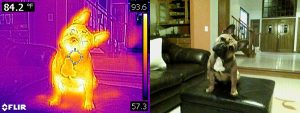
Jerry’s dog, Beignet, as seen through an ordinary and infrared lens system. The infrared camera measures the heat signature and temperature differential of the objects in its frame. Image: Courtesy of Jerry Forrest.
These cameras today are more compact and advanced than ever, explains Jim. “When I first started in the field, infrared cameras were carried by a two-wheel transporter cart. A single imager weighed over forty pounds and produced low-resolution, difficult-to-interpret imagery.” Not so today, he adds. “Now, quality infrared imagers can easily fit into your hand, and the capabilities of the technology are beyond what we could have dreamed of in the 1980’s.”
The art of interpreting the invisible
Today’s cameras may be high quality and easy-to-use—but just like you need a doctor to read an x-ray, a trained specialist is needed to interpret an infrared image. “This is not a point-and-shoot technology,” explains Jim. “It requires an operator who understands infrared theory, heat transfer concepts and the construction and operation of the system and structures being imaged.”
In fact, home inspection is one of the most intricate applications of thermal imaging. Why? “There are an almost infinite combination of materials, machinery, and construction details that make up the structure of a home,” Jim describes. “Knowing how these systems and materials interact is part of the art of being a professional thermographer.”
Training can make the difference between finding or overlooking a significant issue. Here’s an example: Depending on its location, a spot of thin insulation may be little more than a nuisance for a homeowner. By contrast, latent moisture is almost always a more serious issue and can lead to mold and even structural damage if left undetected. Yet the thermal patterns associated with these two issues can look remarkably similar.
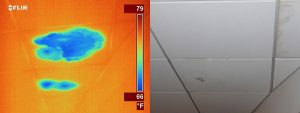
Thermogram shows latent moisture (blue area) in acoustic ceiling tile due to roof leak above suspended ceiling. Image: Courtesy of Infraspection Institute.
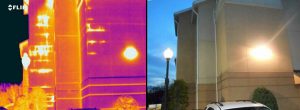
Thermogram shows extensive water damage (irregular white shapes) in EIFS cladding. Image: Courtesy of Infraspection Institute.
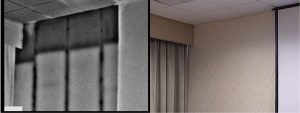
Thermogram shows cool areas (dark gray) caused by missing batt insulation in four stud cavities of a framed wall. Dark gray vertical lines indicate position of studs within the wall. Image: Courtesy of Infraspection Institute.
To gather meaningful data, consultants must consider things like home usage, time of day, environmental conditions and imaging vantage point. To understand thermal imagery, they must rely on their training and experience.
Jerry echoes that the importance of preparation can’t be underscored. “A visit is a real opportunity to check on the health of your home,” he adds. “We want to add as much value as we can.”
Each one of Berkley One’s Risk Management Consultants is professionally certified by Infraspection Institute, invested in learning and utilizes a high-caliber camera on every home they visit. There are no eligibility thresholds for a home to receive thermal imaging services. “I complete a scan for every single property I visit,” Jerry adds, “Because every home is subject to loss!”
Ready for your home’s close up?
What do Berkley One’s Risk Management Consultants look for during an infrared scan? “Actually, I don’t look for anything in particular, because I don’t know what I’m going to see” Jerry explains. “I keep an eye open for anomalies—when I see one, that’s when I start to ask questions.”
Berkley One assesses over 30 interior and exterior points in our inspection. Infrared technology can help us find:
- Electrical issues, such as loose connections, overloaded circuits or faulty equipment. This can help prevent electrical fires.
- Heat and energy issues, such as insulation issues or hot spots in attics. This can help prevent ice dams and pipe ruptures.
- Latent moisture, such as water damage from roof leaks, building envelope leaks or plumbing leaks. This can help mitigate and prevent further damage, including structural damage or mold.
For Jerry, the best part of a home scan is still sparking a conversation.
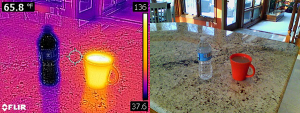
A water bottle directly from the fridge and a fresh cup of coffee. Notice the temperature divergence from 37 to 136 degrees between the two beverages. Image: Courtesy of Jerry Forrest.
“I’ll take a photo of a window to show a client energy loss, or a hot cup of coffee to show a temperature differential. I can see their eyes light up when they understand. More than anything, it’s about helping clients be aware of all the things in their home that directly impact their property and safety.”
And that starts the relationship off on the right foot.



